| |

Home
Thousands of tastings,
all the music,
all the rambligs
and all the fun
(hopefully!)


Whiskyfun.com
Guaranteed ad-free
copyright 2002-2022
|
 |
|
| Hi, this is one of our (almost) daily tastings. Santé! |
| |
|
| |
| |
February 12, 2022 |
|
  |
20 Descriptors |
Trying what's inside our whiskies
while Angus is on parental leave |
To each his references! (Thinking about you, Peter.) |
When tasting whisky, or any other spirits, or wine, we often come up with descriptors that are actually other drinks, wines, beers, liqueurs, mezcals, whatever. But do we sometimes make sure that those are truly there? Is that 'violet liqueur' that we would find in, say a Bowmore 1985, violet liqueur indeed, or only vague, distant reminiscences of what may have been some kind of liqueur that we would have tried around 1990? There's only one way to find out… Have them! |
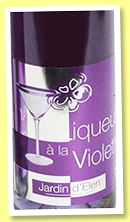
|
Liqueur à la Violette (25%, Le Jardin d'Elen, France, +/-2021) 
This wee liqueur straight from Toulouse Airport (Blagnac), Toulouse being one the capital cities of violette/violet. They would recommend you drink this in a Kir Royal (1/10 liqueur, 9/10 champagne) or with ½ vodka, which I wouldn't do, really. Good, let's have it neat! Colour: almost blue. Nose: if I say Bowmore 1985 that won't be of great help. Violets, really, which is nicer than Parma Violets, but still a tad too aromatic. There's also that liqueur called parfait amour that contains a lot of violet, but it's also got geranium and orange, while this very one's 100% violet. All right, that feels… Mouth: where's champagne when you need it? A feeling of having wolfed down a whole family pack of assorted wine gums. A lot of sugar. Finish: medium, a tad cloying, extremely sugary. Comments: not meant to be drunk like this, I suppose. Or on a ton of ice.
SGP:910 - (no) points. |
Next thing we sometimes find is woodruff… |
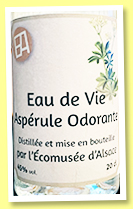
|
Eau de Vie d'Aspérule Odorante (45%, Ecomusée d'Alsace, France, +/-2020) 
Watch this, aspérule/woodruff can produce a magnificent spirit but it is a lot of work. Woodruff is a tiny white flower that you would find in the woods (Sherlock!) and that old people used to let dry and then smoke whenever they wanted to quit smoking tobacco. No, no hallucinogenic properties… Colour: white. Nose: sumptuous, on many tiny aromas, starting with bitter almonds, sesame oil, gentian and celeriac, going on with fennel and wild carrots, and ending up in honeyed territories (heather, manuka). The closest thing would be mullein eau-de-vie, another flower. Mouth: totally love this, even if it's a little rough and perhaps a little too spicy here and there. Perhaps a little soapy as well, otherwise we have bitter roots, green pu-her, caraway and juniper, cinchona, and something very earthy. A tough boy and guess what, it's absolutely not floral. Finish: long, grassy. Turnips perhaps, more celeriac, parsnips, pepper… Indeed, it's lovely but it's not easy. Comments: my kind of whacky spirit. Talisker from the high mountains.
SGP:273 - around 85 points. |
Sometimes, we also find herbal liqueurs, such as… |
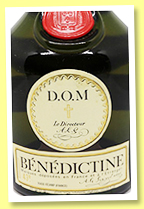
|
Bénédictine D.O.M (40%, OB, France, +/-1970) 
From a stash of the kinds of old bottles that anyone in France would have hidden in grandma's old Henri-II cupboard. Bénédictine is a very old herbal liqueur made in Fécamp, Normandy. These old bottles are fetching high monies at auctions these days, almost like Chartreuses. Think around 250€. Colour: straw. Nose: wow, now I understand why those 250€. Fantastic aniseed-led development on many herbs, woodruff (what, again?), fennel seeds, star anise, liquorice, cumin, with touches of green bananas, honeydew, bamboo shoots, gentian again and again, perhaps a drop of moutai… Wonderful nose, and I'm no liqueur guy. I may like this better than chartreuse. Mouth: perhaps a wee tad too much on the sweet side, but other than that, it is liquid liquorice, with some menthol, agave syrup, pine extracts, bitter oranges, and hundreds of small herbs from our woods and meadows. Don't monks make this? Finish: long, perhaps a wee tad soapy, as many herbal liqueurs can be in my book, but it is not cologne-y. A feeling of Gravenstein eau-de-vie. Comments: huge surprise here at Château Whiskyfun.
SGP:771 - probably around 88 points. |
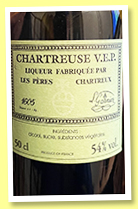
|
Chartreuse V.E.P. (54%, OB, France, 2001) 
From the same stash of old bottles. The back label indicates when it was bottled. V.E.P. means 'Veillissement Exceptionnellement Prolongé', which means 'Aging Exceptionally Prolonged'. I have to say I'm surprised no Douglas Laing or other very distinguished Scottish marketing wizards have ever used that kind of acronym. You say they have? Colour: green, so this is a green chartreuse (very well done, S.) Nose: indeed I liked the Bénédictine rather better. This one's rather about herbs, mint and terpenes, and basta. Nothing wrong with that, and sure there are better cuvées of chartreuse, but it' also getting immensely piney. Got to enjoy that. With water: thyme oil and benzine. Not too sure. Mouth (neat): heavy, thick, rather cloying, extremely herbal and piney. A feeling of drinking a bottle of mouthwash. With water: hold on, pears? Quite some sugar too, and of course a lot of piney flavours. Finish: very long, killing anything that would come after this. Drinking balm. Comments: we've got many friends who are Chartreuse enthusiasts, and who would know about all the different Tarragones by heart, for example. Not this humble taster, I'm afraid, I may be missing that gene.
SGP:780 - around 65 points
(I'll have to watch my back in the coming months, on the other hand the makers completely ran out of VEP last year). |
There's another very herbal thing that I sometimes mention, that would be… |

|
Underberg (44%, OB, Switzerland, +/-2020) 
A pretty bitter liqueur, sometimes said to be German on some websites but the one I've got stems from Dietlikon, around Zürich. Underberg is said to contain herbs from 43 different countries, which I find a little hard to fathom, but there. It is sold in tiny 2cl bottles and is supposed to be extremely postprandial. In short, you could have wolfed down a dozen T-bones and three kilos of foie gras, you'll remain fine. Colour: dark coffee. Nose: extremely medicinal indeed, that old Chartreuse was much lighter, almost Glenkinchie-light. Huge cumin and caraway, plus juniper and just tons of cloves. Hundreds of tons of cloves. Mouth: really an acquired taste. I suppose the main effect here is that you just couldn't eat anything after this. Postprandial indeed. Extreme cloves. Finish: more cloves, for eternity. And perhaps artichokes, bitter bark, pepper, and indeed a lot of caraway too in the aftertaste… Comments: there's only 2cl but I find even 1 single cl a little excessive. What's good is that it's dry and seem to contain very little sugar. We'll have a to make a long break before we could try any other drink, or even eat half an oatcake… Like, two hours, minimum.
SGP:281 – around 70 points. |
Good, we're back… What we always mention too is mint, menthol, peppermint, or crème de menthe. One of the most famous drinks in that respect, in France, is Peppermint Get, a.k.a. Get 27. |
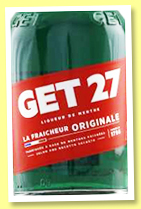
|
Get 27 (27%, OB, France, +/-2000) 
Indeed, this an old bottle but it's in good shape, with no crystallisation. I believe the brand belongs to Bacardi. There is/was also a stronger version, branded Get 35. In the old days, we were always having some Get 27 or 35 before dancing 'collé-serré', but that was before techno… Colour: between turquoise and fir green. Nose: mint, mint lozenges, menthol, peppermint, toothpaste, mouthwash… And that's all. That was all the point anyway, not to have a funky breath like dead things. Mouth: mint syrup and alcohol, with some nice-ish honeyed notes that, I swear, weren't there when this bottle was produced. OBE in Get 27, wow! Finish: not long enough and that's why we used to quaff one glass after another. Some were downing whole bottles! Comments: the thing is, I love mint. First time I'm drinking Get 27 since around 1985… Oh by the way, I've just seen that they're using seven different kinds of mint. Really!
SGP:750 - around 75 points. |
Another favourite of mine now, gentian! We've already published a few notes for gentians, but let's try another one… |
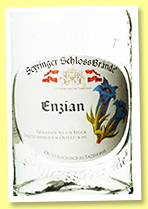
|
Enzian (37.5%, OB, Seyringer SchlossBrände, Austria, +/-2019) 
Enzian means Gentian, right. I'm afraid this won't be a top-class gentian, given that they've bottled it at some lousy strength. Most certainly 'macerated' eau-de-vie, so not really eau-de-vie. Colour: white. Nose: no, it's pretty nice, very rooty and earthy, as gentian should be. If you've never tried gentian, imagine some cut celeriac to which you would have added a little aniseed, with a clear medicinal side. Very nice. Mouth: a tad brutal despite the lower strength, certainly less high-precision than on the nose, but there's also a saltiness while in my book, that always works. Oh yeah, when you distil gentian, you use the roots and neither the flowers nor the leaves or stems. Just in case you didn't know. Finish: long, with a little horseradish and mustard, on top of all these lovely earthy notes. Salty aftertaste. Comments: I was wrong, it's a good gentian, well done. Oh and they're located near Bregenz, not far at all from lovely Lake Constance.
SGP:363 - around 85 points. |
Come on, don't tell me you didn't see this coming… |
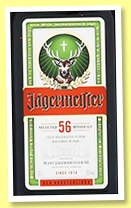
|
Jägermeister '56' (35%, OB, Germany, +/-2020) 
We quote the Master Hunter all the time, in my book it's one of the epitomes of herbalness but it is also the one that everybody knows. No, we don't do Jägerbombs or shooters. Colour: coffee. Nose: some kind of lighter and rounder Underberg, with a lot of liquorice, cinnamon extracts, cloves indeed, pine resin and cardamom, with some orange liqueur too. Well, this baby's not quite as herbal as I remembered it but let me be honest, I hadn't actually tried Jägermeister since a party on Majorca, ach, err, thirty years ago. I think it's good that we all try our main descriptors more often… Or change them! Mouth: more on mint and caraway this time, certainly more herbal than on the nose (phew) and, I would say, a tad unpleasant, cloying… Liquorice, pine resin, cloves, cardamom, aniseed, ginger… Finish: caraway! Comments: you would understand why people drink it either hot, or chilled. Room temperature may not be the right temperature.
SGP:771 - around 60 points. |
That's eight, right… Caraway, he said… |
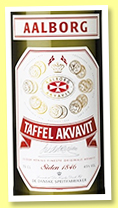
|
Aalborg Akvavit (45%, OB, Denmark, +/-2018) 
I remember we had tried some Linie Aquavit a few years back, and thought it wasn't bad at all, as far as I can remember. This should be all about caraway… (which is basically a small cumin from the fields). Colour: very very pale white wine. Nose: caraway everywhere indeed. My old uncles used to drink this kind of schnapps after a meal. Caraway, a little soap, perhaps poppy seeds… It's not bad at all on the nose, it's just extremely narrow. Mouth: a thick spirit, peppery and just totally shock-full of caraway. Now I remember, my old uncles used to drink this kind of spirit with Munster cheese. Tough stuff. Finish: extremely long, with loads of caraway and touches of lemon zests, which would make it bizarrely refreshing. Comments: this should take ice nicely. May wreck your glass, though… Seriously, I rather like it, I'm just not used to these rather extreme flavours and aromas.
SGP:272 - around 75 points. |
That's nine. Hold on, didn't we just mention lemon?… But of course, one of our #1 liquid descriptors would be… |
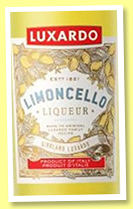
|
Limoncello Luxardo (27%, OB, Italy, +/-2018) 
They seem to be using various labels, are those different cuvées? Luxardo is a well-reputed small house, first founded in Croatia, then moved to Padova. They're very much into cherries, but indeed this is a lemon liqueur which, apparently, originated around Naples. I would say I must be using the descriptor 'limoncello' at least once every fifty spirits, if not more. In my experience, Limoncello is extremely hard to make yourself, you're soon to make it a little too 'chemical'. Believe me, I tried. Colour: fluo yellow. Nose: it's really about lemon juice and sugar, lemon balm, and more lemon balm, and more lemony stuff, lemon syrup… And zests… As we sometimes say, there's more lemon than in lemons, what's cool is that it doesn't smell like detergent… Mouth: nice, easy, fresh, too sweet for me of course but there, and really all on lemon and sugar. Finish: too sugary, I'm sorry. Extremely sugary, and just touches of zests in the aftertaste. Comments: are you really supposed to drink these Limoncellos at room temperature? But it's a good limoncello, we've tried some that had been much 'worse'.
SGP:830 - around 65 points. |
Good those were the first ten, let's take a (very) long break… |
We're back. Last time, we found out that many descriptors were better IN whisky than OUTSIDE whisky, although we had stumbled upon some wonderful woodruff eau-de-vie, old Bénédictine, and Austrian gentian/Enzian. Let's kick off this new session with something that I just adore, cherries… |
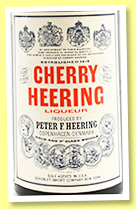
|
Cherry Heering (OB, cherry brandy, Denmark, +/-1970) 
'Try it chilled' is what they had added to the back label. Not quite a good sign… Now this is an old bottle indeed, this juice being now called simply Heering or, sometimes, Peter Heering. I have no explanations why but I haven't been looking for any. This one has no ABV statements but current offerings do state 24% vol. Colour: black. Nose: moist and heavy pipe tobacco! A lot of it, really, plus bigarreau cherries in Kirschwasser and Kriek beer. But the pipe tobacco is ultra-dominant. I remember some very black Dunhill… Mouth: sweet, very tobacco-y, full of cherries, and just excellent, in my opinion. I would suggest some good OBE's taken place as this is very complex, also full of gingerbread, Christmas pudding… I believe I'm going to buy a contemporary bottle and check what gives. Very intriguing but then again, I'm a sucker for anything 'cherry'. Finish: long, complex, you would almost believe someone's blended some old Chambertin with some old Port. Tsk-tsk. Comments: I'll really have to check it… or seek older bottles.
SGP:740 - around 85 points. |
Hold on, we found a new bottle of Heering! |
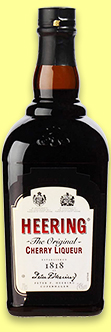
|
Heering (24%, OB, cherry brandy, Denmark, +/-2020) 
Let's do this quickly, this is not a cherry brandy session… Colour: purple mahogany or something. Nose: more on only cherries and no pipe tobacco this time. Pretty nice but you'd rather feel that it's better to pour this over vanilla cream… Mouth: is this thick! Indeed it is pure cherry liqueur, extremely sweet, and reminiscent of what we call guignolet here in France. It's good because I love cherry flavours, but I doubt you could actually quaff this like this, at room temperature. Finish: extremely sugary. Eating a very large bag of candied cherries. Comments: I suppose this was meant to be a 'component'. For a cherry spritzer? The old one was on another planet but then again, that may have been the mysterious wonders of OBE. That also explains why high-street mixologists and baristas have been so busy looking for old bottles of liqueurs for a good decade or two…
SGP:920 - around 70 points. |
Good, since we're doing cherries, so to speak, let's switch to maraschino, another favourite descriptor of mine… |
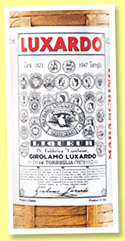
|
Maraschino Originale Luxardo (32%, OB, Italy, +/-2018) 
A liqueur made out of marasca cherries and, apparently, Luxardo's most famous product. As I understand it they would let those cherries macerate in neutral alcohol, then distil it all to a spirit, which they'll then bring down to 32% using sugared water. Colour: white. Nose: absolutely not only on cherries, rather herbal and earthy, with notes of bitter almonds and chestnut husk. Touches of fennel, salsify, turnips, caraway… Blind you would have said some herbal liqueur. Mouth: there, this is rounder and sweeter, and indeed a little more on cherries, but it's got nothing to do with the stuffy Heering. A little ginger, aniseed, fennel, liquorice… And perhaps aquavit. Sloe as well, prunella… I find it very nice; I'd have just preferred it with a little less sugar. As always. Finish: medium, rather clean, sugary, but pretty complex. Roots and almondy cherries. Comments: I would quaff this, really, preferably in a glass that had been quickly chilled in the freezer.
SGP:740 - around 80 points. |
Each and every time we're trying to do some freewheeling session we end up with order and logic. I hate that, but let's get over it with some… Kirsch a.k.a. Kirschwasser. |
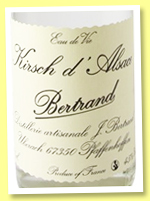
|
Kirsch d'Alsace Bertrand (45%, OB, France, +/-2015) 
A great distillery located in Uberach, in the north of Alsace. That's where our friends also make the whisky Uberach and their famous Bierski. Good stuff and great master distiller. Colour: white. Nose: some obvious parentage with the maraschino, with a similar almondy side and some rooty earthiness, while the cherries themselves have not been very aromatic. Better like this if you ask me, the spirit remains elegant and even distinguished. Good kirsch should never be a cherry bomb! Mouth: indeed, a very grassy, leafy Kirsch, not on the fruits at all, rather on tobacco, olives, almonds, and just various roots. There's even a little salty liquorice in the background. Finish: medium and even more on olives, which remains surprising. Lovely rooty aftertaste. Comments: a great Kirsch, just not for tourists, if you see what I mean. Great work, Bertrand.
SGP:362 - around 85 points. |
Too bad no one's distilling olives, unless I'm wrong again; don't worry, we won't try olive oil… Oh wait, when there's a will there's way… rummage rummage… See what we've found!... |
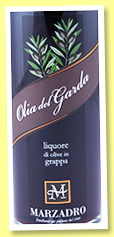
|
Olia del Garda Marzadro (40%, OB, Italy, +/-2019) 
I had almost forgotten I had this! It is 'Liquore de Olive in Grappa', that is to say olives cold-infused in grappa, an old recipe from the Lago di Garda. Colour: mahogany. Nose: I don't know, aniseed? Limoncello? Aquavit again? I'm not sure I'm finding the olives and neither am I finding the grappa, but it's most possibly not a drink to nose. Mouth: indeed it is a kind of herbal liqueur, in the style of Jägermeister, only a tad bitterer and grittier, which may come from those olives. No wait, the olives really come out after fifteen seconds, bringing even more bitterness. I would suppose you could season a great pizza using this instead of chilli oil. Finish: long and with even more notes of olives, so actually even more bitterness. It's basically become a bitter, I'm should it would work a treat in some Italia-style bitter cocktails. Notes of green walnuts in the aftertaste. Comments: this one really grew on me, too bad there's a little too much sugar. I'll have to drive to the Lago di Garda in the spring, it's not too far from Alsace! Took its time but a very good surprise.
SGP:680 - around 80 points. |
What's next?... We've mentioned aniseed a few minutes ago, so let's have… anis. |
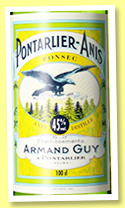
|
Pontarlier-Anis Armand Guy (45%, OB, France, +/-2015) 
Whenever anyone thinks pastis, it's Provence that springs to your mind, cicadas (kss-kss-kss-kss), the Mediterranean, Bardot (what?), Lambos, rosé, and pastis. Except that the original capital city of 'pastis' is located in Jura and is called Pontarlier. Not a city as sexy s St. Tropez indeed, but they've always been great distillers and liquorists down there, south of Alsace. Armand Guy, for example, is a great house and a favourite in the house (in swimming season). We'll have it neat but in theory, you should add water. They say only drunks drink pastis neat, but there, this is for the cause… Colour: light green yellow. Nose: you cannot not think of absinth. This has more aniseed than southern pastis, and probably less liquorice. Very bright, pure, almost refreshing on the nose. Oh by the way, it's said that this was originally absinth and that they just took wormwood out of the recipe when absinth got verboten, in the early 1920s. Mouth: it feels a little strange to drink this neat but it is good, without any obvious ethanol or cheapish alcohols, and rather more on mint and lemon, beyond all the aniseed. Lemongrass. Finish: long and to be honest, you would start to have the feeling of having just eaten a tube of toothpaste. Comments: right, you should rather add 10% water. Come on, 50%. No, 200%! But it is a very great 'anis', believe me.
SGP:580 - around 85 points. |
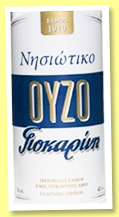
|
Oyzo (40%, Greece, +/-2010) 
One that I brought back from Athens quite a while ago. Basically and as I understand it, oyzo/ouzo is pastis made by civilised people. Should be drunk with water, but… you know, our common cause… Colour: white. Nose: much lighter than the Pontarlier, perhaps a little more on caraway beyond the aniseed, otherwise neat and fine, pleasant, with a little earth, cardamom… Mouth: closer to some traditional pastis, Pernod, Ricard and such. Good, simple, rather on liquorice indeed, with touches of peppermint. Feels like holidays… Finish: same. A tad ethanoly now. Comments: simple but very all right! Sir, may I order a moussaka?
SGP:370 - around 75 points. |
Love aniseed but you cannot have too much, let's move on… Perhaps with something that's extremely uncommon in France and yet that we sometimes mention in our tasting notes? |
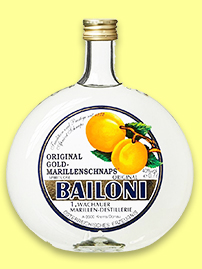
|
Gold-Marillenbrand Bailoni (40%, OB, Austria, +/-2020) 
From Wachau, home to many great rieslings! We don't make a lot of Marillen/apricot eau-de-vie in France because of all the prussic acid that's located in the stones, while if you distil apricots without their stones, you would get a pretty dull and perfume-like spirit. I suppose the trick is to keep only a part of the stones. Well, in theory… Colour: white. Nose: not an easy spirit, it's a tad sour and with whiffs of Brussels sprouts and quite a lot of varnish, but the fruits are there in the background. Wine gums, apricot jam… Those would then take over, which is just lovely. Love, love apricots! Mouth: an acquired taste at first because of the sour vegetables that are there again, and because of all the varnish that blends with some liquorice, but once again the apricots (preserved or as jam) would then come in and just take over. Funny two-step eau-de-vie. Finish: same. Loads of liquorice in the aftertaste, not too sure where that came from. From the stones? Comments: good fun. Many things from Wachau are; like, Pichler…
SGP:571 - 80 points. |
Why not try to find something around that fabulous combo that would be oranges and chocolate? Like in those Jaffa cakes that I often mention… Or Sabra liqueur from Israel, why not… |
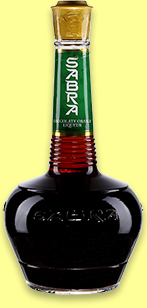
|
Sabra Liqueur (30%, OB, Israel, +/-2010) 
An older bottle, I just cannot remember where it came from as I've never been to Israel, which I regret. Covid doesn't help. Some friends brought it, probably; hey and 'the bottle design is based on a 2,000-year-old Phoenician wine flask found in a Tel Aviv museum'. You always need stories. As for the name Sabra, it's a bit grim, really, but I would suppose they came up with this brand name way before those very sad events. Colour: deep coffee. Nose: bitter cocoa, coffee, sandalwood, eucalyptus, duck sausages (really) and tar. A little weird, I'm not finding any oranges. Mouth: bizarre but a little better than on the nose. A lot of chocolate (cold hot chocolate), and a whacky menthol and eucalyptus combo. Some kind of extreme cough syrup. Finish: pretty long, unexpectedly meaty, with something Mexican (mole). Ginger liqueur in the aftertaste. Comments: another glass-wrecker, not quite my thing. Sure it's 'very different' but I'm not sure chocolate is easy to handle. Feels like medicinal chocolate. They have much better drinks in Israel, such as some wines and most certainly M&H's lovely whiskies. But please don't do a finishing in ex-Sabra casks!
SGP:770 - around 40 points. |
Good, a last one, let's make it a funny one. We do mention honey all the time, don't we? But we won't try mead or chouchens or else, we'll try this… |
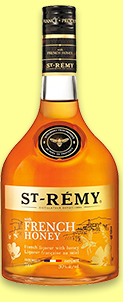
|
St-Rémy Liqueur au Miel (30%, OB, France, +/-2018) 
Made with honey from Provence, they say. If they say so… Looks like this is made by Rémy-Cointreau, which would make sense according to the name. To be honest, the brand is virtually unknown in France, but it seems that it's big elsewhere. On Facebook they claim that 'St-Rémy is the world's favourite and most prestigious French brandy'. I say sorry, but nope. Colour: gold. Nose: fermenting honey, while that's a little uncommon as most honeys wouldn't ferment this easily. Otherwise honey sweets. Fine, but I would prefer HP's heather honeys, for example, or the honeys you would find in a good old '72 Speysider. Mouth: meady. A rather strange, uncertain, somewhat hot liqueur that's rather geared towards the cheapest of all Sauternes. Some sweetness. Better drink Sauternes. Finish: better drink Sauternes. Comments: better drink Sauternes. Love honey but this is disappointing and, what's more, a little vulgar. To think that Rémy also own those superb drinks named Hautes-Glaces, Bruichladdich, Westland or Mount Gay! But honey's extremely difficult to handle. I know, I've tried, I've still got the many bottles in my garage.
SGP:630 - around 30 points. |
That's twenty, auf Wiedersehen. |
|
|
| |
|
|
|
|
|
|

